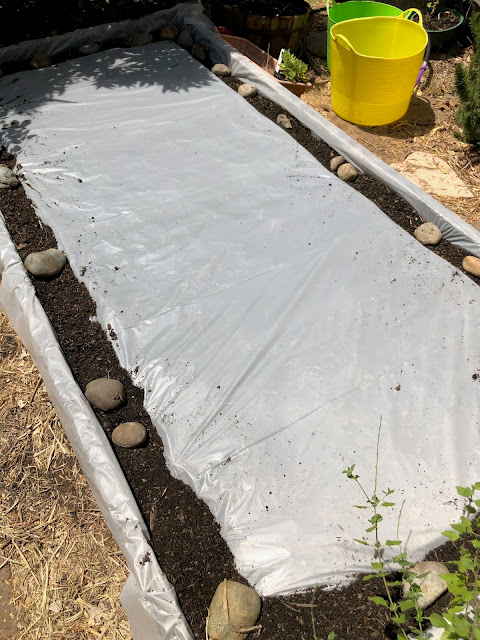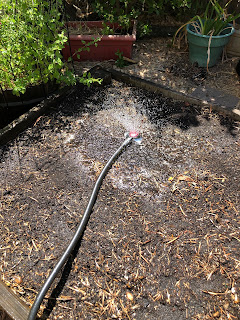
Now's the best time for soil solarization

|
|
Here's my raised bed, all ready for the sun to do its work.
(Photos: Kathy Morrison) |
There's at least one good thing about our hot, no-rain summers: We can easily put the sun to work for us in the garden, solarizing our soil.
Why solarize? It's a natural way to control pests, pathogens and weeds.
My first 4-by-8-foot raised bed was built 20 years ago on the south side of our small backyard. This replacement bed, constructed with better lumber, is 18 or 19 years old. It was my tomato-growing workhorse site for a few years, until I joined my local community garden and moved tomato production there.
Since then the raised bed has had an erratic production history. Beans did well for awhile, and peppers two years. Onions went in at least one year. I most recently had strawberry plants there, but they were not happy and died more often than not. The survivors were moved to grow bags, where they are doing well.
Since I didn't have to plant anything in the home raised bed this year, I decided to try solarizing it to kill off any lingering pathogens (such as wilts), weed seeds or nematodes. We had an overgrown podocarpus tree nearby removed earlier this year, clearing the way for an intense solarization experience.

|
|
The soil needs to be soaked first for
solarization to work. Those remaining
podocarpus leaves also have to go. |
-- Remove any debris from the site and rake it flat.
-- Water it well, down at least 12 inches.
-- Dig trenches along the edges where the plastic will be anchored.
-- Cover tightly with plastic; anchor the plastic with soil (and rocks, in my case).
-- Wait four to six weeks (or more) for the sun to do its work.
-- Uncover and plant. (Though I likely will do a soil test before I put any plants in.)
The plastic sheet I used is 1.5 mils thick, which is within the recommended range for durability. It's not perfectly clear, but clear enough. Black or colored plastic is not recommended. Rolls of clear plastic can be found at most home improvement stores -- look in the paint section.
My raised bed's been set up for a week now. The soil temperature's already up to 98 degrees and the underside of the plastic shows many nice bubbles.
I'll report back later in the summer on my progress. Meanwhile, here's a great guide to solarization from the UC Integrated Pest Management program, if you want to try it. If a video is more useful to you, the Sacramento master gardeners filmed a solarization guide for the 2020 Virtual Harvest Day; see it here .
Comments
0 comments have been posted.Sacramento Digs Gardening to your inbox.
Sites We Like
Garden Checklist for week of May 12
Get your gardening chores and irrigation done early in the day before temperatures rise.
* Plant, plant, plant! It’s prime planting season in the Sacramento area. Time to set out those tomato transplants along with peppers and eggplants. Pinch off any flowers on new transplants to make them concentrate on establishing roots instead of setting premature fruit.
* Direct-seed melons, cucumbers, summer squash, corn, radishes, pumpkins and annual herbs such as basil.
* Harvest cabbage, lettuce, peas and green onions. This heat will cause leafy greens and onions to flower; pick them before they bolt.
* In the flower garden, direct-seed sunflowers, cosmos, salvia, zinnias, marigolds, celosia and asters.
* Plant dahlia tubers. Other perennials to set out include verbena, coreopsis, coneflower and astilbe.
* Transplant petunias, marigolds and perennial flowers such as astilbe, columbine, coneflowers, coreopsis, dahlias, rudbeckia and verbena.
* Keep an eye out for slugs, snails, earwigs and aphids that want to dine on tender new growth.
* Feed summer bloomers with a balanced fertilizer.
* For continued bloom, cut off spent flowers on roses as well as other flowering plants.
* Got fruit trees? If you haven't already done so, thin orchard fruit such as apples, peaches, pears, pluots and plums before they grow too heavy, breaking branches or even splitting the tree. Leave the largest fruit on the branch, culling the smaller ones, and allow for 5 to 6 inches (or a hand's worth) between each fruit.
* Thin grape bunches, again leaving about 6 inches between them. For the remaining bunches, prune off the "tail" end, about the bottom third of the bunch, so that the plant's energy is concentrated in the fruit closest to the branch.
* As spring-flowering shrubs finish blooming, give them a little pruning to shape them, removing old and dead wood. Lightly trim azaleas, fuchsias and marguerites for bushier plants.
* Add mulch to the garden to help keep that precious water from evaporating. Mulch also cuts down on weeds. But don’t let it mound around the stems or trunks of trees or shrubs. Leave about a 6-inch to 1-foot circle to avoid crown rot or other problems.